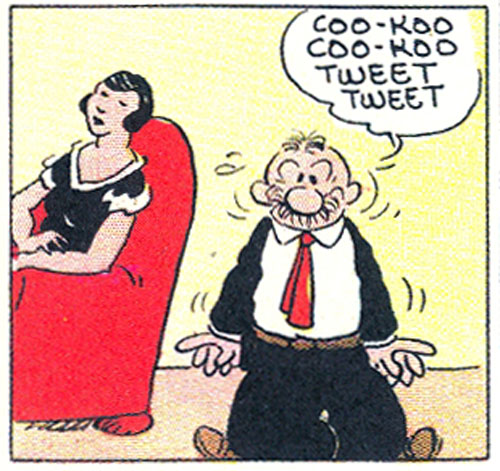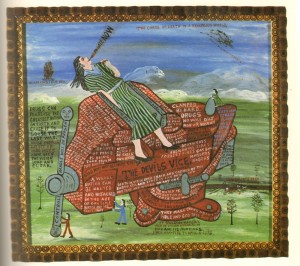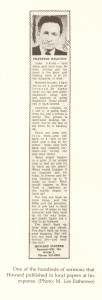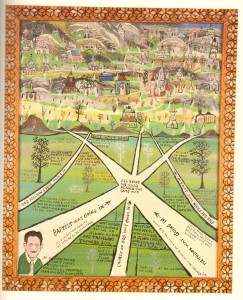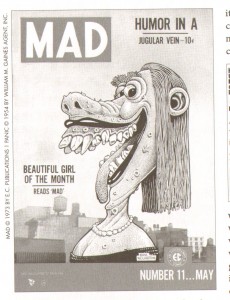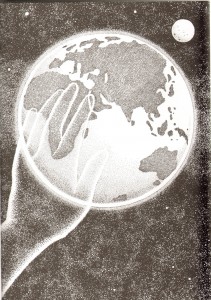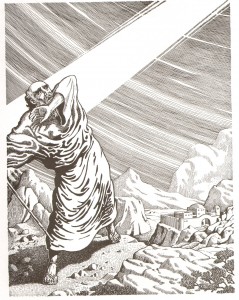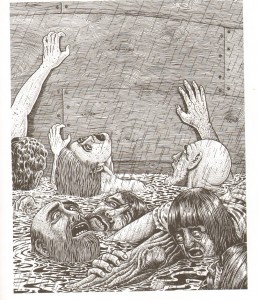I wrote this almost twenty years ago for a course on representations of war when I was a junior in college. It touches on some issues raised in the comments section of Alex Buchet’s recent post on war comics, so I thought I’d resurrect it. I think I still agree with the main points, though the prose would probably be a trifle less earnest if I wrote it now. But, for better or worse, here it is.
_____________________________
“All children, except one, grow up,” writes J.M. Barrie at the beginning of Peter Pan. In many ways, the fictional constructions of war created by Tennyson, Kipling, Remarque, and Zola, appear to be attempting to deny this insight; appear to be attempting to suggest that war provides a return to an idyllic youth and innocence which allows the men who participate in it to escape from the mores and constrictions of adult society and return to an idealized childhood in which manners and restraint are cast away and replaced by simplicity and exuberant enthusiasm. War, for these authors, is an arena in which adventures can occur; in which heroism and enthusiasm triumph over the stodgy grind of day to day life. One can almost hear the cavalry in Tennyson’s “The Charge of the Light Brigade” declaring, with Peter Pan, “I’m youth, I’m joy” as they thunder towards the artillery guns, can almost hear Peter’s cocky self-assurance in Kipling’s breezy assumption that “of course” the British forces broke the “Fuzzy-Wuzzies”. The soldiers of which Kipling, Tennyson, Remarque and Zola speak have no fear, they have no doubts. They live, like children, in their own world with their own rules, in their own “NeverNeverland” separated entirely and forcibly from the reach and understanding of adult society.
Yet, despite this separation, the soldier is not ostracized, not attacked or unaccepted by the society which he seemingly rejects. He is not, in fact, a threat to civilized society, but is rather a delightful dream, an idea with great appeal both to the emotions and to the imaginations of people of the time, as the popularity of Charles Gordon demonstrates. Thus Kipling’s “Tommy” is a man (or, perhaps more correctly, a boy) who should be admired and loved even though he does not really fit the mores and norms of society, even though, as Kipling puts it, his “conduck isn’t all your fancy paints”. It is, in fact, Tommy’s separation from fine society which make him an attractive figure; his very simplicity, the very fact that he does not want luxuries but only wishes to be treated “rational”, composes his glamour. Tommy does not want “better food”, but only to be accepted by society without having to conform to its rules. He wants (and appears to receive from Kipling) to be given the freedom not to conform and to be admired for his very possession of that freedom; wants, like Peter Pan, to receive unconditional affection and yet to never have his mind cleaned.
It should, of course, be impossible to be at one and the same time independent and dependent, impossible to be heroic for the sake of the sympathy and admiration which that heroism brings. Only if one is capable of a total lack of self-reflection and self-awareness is this contradiction resolvable; it is only through his total naivety that Peter Pan is able to both expect admiration and receive it. Through war, Kipling, Tennyson, Zola and Remarque appear to suggest, through becoming a soldier, this simplicity can be (re)gained, this idealized childhood can be (re)found. Soldiers, like children, are, for these authors, not concerned with whether what they do is correct or incorrect, they do not agonize–they simply are. The soldiers whom Zola describes are “Like children and savages, their only instinct…to eat and sleep in this rush towards the unknown with no tomorrow”, Remarque’s Paul notes that “The national feeling of the tommy resolves itself into this–here he is.” The soldier is unthinking; in fact, thought is his enemy, his destroyer. The self-reflection which connotes adulthood, the loss of innocence and unselfconsciousness, results, in these fictions, in age and death. When the soldier begins to think, as Lapoulle does after killing Pache, he is destroyed. As Remarque’s Paul says, “we [the soldiers] are in a good humour because otherwise we should go to pieces.”
Remarque, of course, is contending that it is the horror of war, not of adulthood, which makes this jollity necessary; that to think about war would cause madness, insanity. But in many ways Remarque’s novel makes a statement not that war is too awful to think about, but that it is, in fact, aging which is the greatest horror. It is for this reason that the older men in the War are not as tragic as the men of Paul’s generation, for the older men have no youth to lose. For Remarque, the tragedy of the war is a loss of childhood, is the fact that through the war, Paul discovers death and sexual initiation (“the curse of a soldier” as Kipling writes), fear and vulnerability. Yet all of these discoveries are, in fact, not unique to wartime; as Paul himself realizes, they are instead the necessary adjuncts of adult life, the manifestations of a superficial society which delivers coffins punctually before a battle and places you under the arbitrary control of a postmaster. The war is the extension of civilian societies cruelties and artificialities, stupidities and absurdities. But even as it is so, the war also provides a means of escape, a strategy of resistance, a means whereby youth can be retained through “the finest thing that arose out of the war-comradeship.” Through this camaraderie, the trappings and foolishness of civilization, the unnecessary clutter of the school room, can be shrugged off and subsumed in the contentment of a good meal tasted among good friends. Paul relishes the experience of sitting with his comrades on their makeshift toilets not in spite of the primitiveness of the facilities, but because of it. Remarque views culture and civilization with suspicion, and finds in war a way to sidestep them, to return to the idyllic childhood which Zola describes the young intellectual Maurice finding in the arms of the simple peasant Jean when “Maurice
…let himself be carried away like a child. No woman’s arms had ever held him as close and warm as this…Was this not the brotherhood of the earliest days of the world, friendship before there was any culture or class, the friendship of two men united and become as one in their common need of help in the face of the threat of hostile nature?
Through his relationship with Jean, Maurice regains infancy; he is tended too, sheltered, cared for. War in The Debacle provides Maurice with a way to return to simplicity, with a means of becoming both noble and tragic. He becomes one of the “poor boys, poor boys” to whom his sister refers; he becomes innocent. In its creation of an arena in which life becomes more simple and true, war also, then, absolves of guilt even as it confers naivete. The soldier makes a sacrifice for crimes he did not commit. Like the men of the Charge of the Light Brigade, he goes unquestioningly to his death, following orders to the last. The betrayal of the soldier by civilians and generals is made all the more poignant because the soldier has done nothing wrong; has, in fact, placed his whole trust and hope upon civilian assurances of glory and easy victory. The betrayal is, in fact, like the betrayal which Peter Pan experiences at Hook’s treachery on the rock in the lagoon, the betrayal of a child’s total trust by a parent’s unfairness, after which, Barrie writes the child “will never afterwards be quite the same boy.”
It is this betrayal which Paul feels has robbed him of his youth when he says that, “I am young, I am twenty years old yet I…see how peoples are set against one another, and in silence, unknowingly, foolishly, obediently, innocently slay one another. [italics mine]” Remarque claims, then, both that the soldiers have lost their innocence, and that they retain it. Remarque says that their parents have failed them, and yet he still conceptualizes them as children. They have discovered that the world is unfair, and yet Remarque, through Paul, still perceives them as innocent. Paul repeats over and over that his generation is lost, it is useless, it is old and destroyed, but he never once decides to stop fighting, and even pushes Himmelstoss forward when the former drill master falters. Self-consciously martyred, Paul cannot solve, but can only revel in his troubles, just as Mr. Darling revels in his sojourn in the kennel.
Mr. Darling is, of course, not really comparable to Paul. He is not as young, nor in as much distress; he was not in the trenches of the First World War. Yet, in a deeper sense, Mr. Darling is very much like Paul, very much like Maurice, very much, for that matter, like Charles Gordon. He is a man who wishes more than anything to be admired, as Paul and Maurice did when they joined their respective armies, but who, through that very wishing, has condemned himself to an unadmirable existence. He is a conceited fool, a whining incompetent, a desperately contemptible figure when placed beside the apogee of unconscious grace and youthful innocence which is Peter Pan. And yet, while no one would want to be Mr. Darling, no one can wish to be Peter Pan either, because the very wishing dooms the attempt. One either has “good form” or does not have it. To have good form is to be young, unconscious, free. But “All children, except one, grow up.” And that one, as Barrie surely knew better than anyone else, was not real.
This is, I think, Barrie’s central insight, is the reason that Peter Pan , if it does not really oppose war, offers a way to oppose war that none of the other pieces of literature we have studied manage to suggest. For if, in fact, childhood is unattainable, if simplicity is gone, then the attempt to recapture that simplicity and childhood through war is not only misguided, but is actually dangerous, futile, and pitiful. Barrie loved children, he loved childhood. But he knew that he was not a child, and that he could not become one by travelling to some foreign field with a rifle and a battalion of comrades. Childhood games played by adults are not touching or cute; they are pitiful and even terrible. When Mr. Darling pours the medicine into Nanna’s bowl, he does not appeal to the reader in the same way that Peter does when he plays the game of question and answer with the pirates. Similarly, Peter’s comment that “to die will be an awfully big adventure” is charming and witty only when uttered by Peter’s naive voice. Kipling’s effort to capture what appears to be a similar sentiment sounds incredibly cold-hearted and callous, advising as it does that a soldier wounded on the field of battle and facing imminent mutilation ought to “Jest roll to your rifle an’ blow out your brains.” On the other hand, the French mutineer’s letter telling his sweetheart that, “I love you, and I don’t want to die”, is touchingly painful, and would be just as out of place in Peter Pan as would Kipling’s injunction. Real horror (though apparently Kipling, whose brain may itself be scrambled in some anomalous fashion, does not know it is real horror), and real fear are not part of the world which Barrie describes.
This is, of course, because Barrie’s world is not real. NeverNeverland is named so for the obvious reason. Tennyson, Zola, Kipling, and Remarque, in attempting to locate it within the context of reality, in attempting to suggest that NeverNeverland is obtainable within a historical rather than an imaginary framework, trap themselves within the very mundane existence that they wish to escape. In trying to escape adulthood, in trying to leave behind their responsibilities, they succeed only in making Mr. Darlings of themselves, only in placing themselves in a continuum where they refuse to face their problems because they wish so badly to transcend them. Tennyson cannot feel outrage or shock at the death of the Light Brigade, Zola can create only shallow caricatures in the place of real characters, Remarque can not move past self-pity and gruesome imagery to register any deep and meaningful moral objection to the carnage he witnessed, and Kipling appears to have buried any decent human compassion at all beneath a glut of imperialist fervor. Each is left romanticizing stupidity and horror in the hope that in doing so they can rediscover the childhood that they have lost.
Barrie offers no alternative to this quest. He, too, cannot turn from childhood, cannot stop seeking Peter Pan. But he knows, as Tennyson, Kipling, Zola, and even Remarque do not seem to, that the quest is futile, knows that Wendy and John and Michael and the Lost Boys must grow up eventually, must take up a mundane existence no matter how boring or dull it appears. And once it is recognized that war is not a return to some idealized NeverNeverland of childhood, then perhaps a convincing opposition to it can begin to be formulated.

